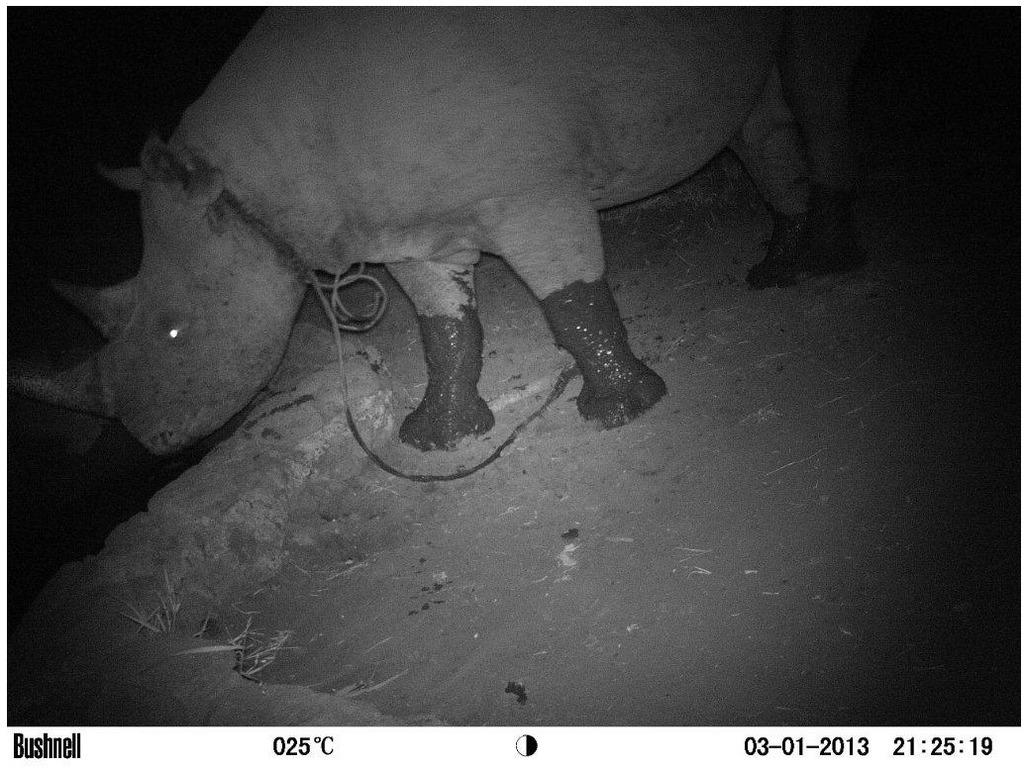
THE ONGOING DRAMA OF THE SEARCH FOR THE SNARED RHINO IS IN A SERIES OF POSTS BELOW, THE MOST RECENT AT THE BOTTOM
by Richard Bonham, March 12
The attached photo is from one of our camera traps that we use to monitor the last few Black Rhino left in the Chyulu Hills. A male Rhino has been caught in a wire cable snare set by poachers which he managed to break.
We don't know how long he has been dragging the cable but he will certainly die if we are not able to find him, immobilize him and remove the snare.
But that is easier said than done. We have had a joint operation with 30 rangers searching sometimes nearly impenetrable bush for 48 hours, and found no sign. We have flown 6 hours in the Super Cub looking as well.
As I write, rangers are setting 10 more camera traps in the hope of locating him, but even if we do, the next step will be even more difficult, as darting a rhino in such thick bush is no easy exercise, and potentially very dangerous, especially an injured bull.
As a back up the Kenya Wildlife Service have put a helicopter and vet on on standby, ready to fly in at short notice.
Time is now the essence. We have to find him in the next couple of days otherwise infection will get in, and he will die. And with that, the viability of another black Rhino population will further hang in the balance.
UPDATE MARCH 16:
Thank you everyone for your messages of support. I am afraid we have no positive news yet, despite a massive operation launched by KWS and Big Life. KWS sent a helicopter to support our Super Cub in an aerial search but no luck. On the ground we now have about 40 men, after KWS deployed more rangers to assist, but the very nature of the dense habitat which has protected the rhino is now the enemy.
The news from the rest of Africa is not good either: so far this year 111 have been slaughtered in just two months, to fuel the Far East’s insatiable appetite for powdered rhino horn ‘medicine’.
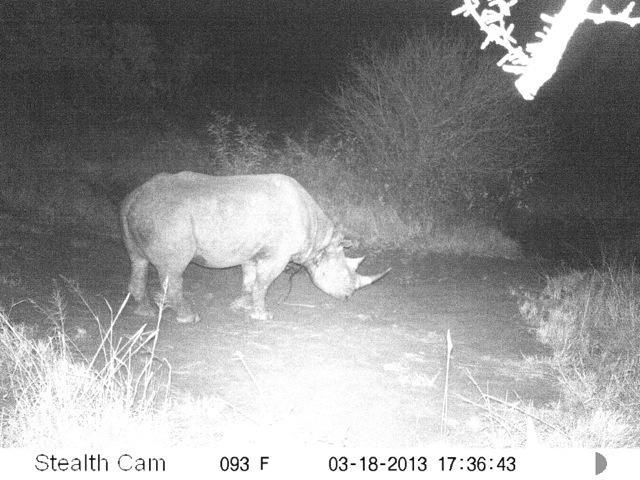
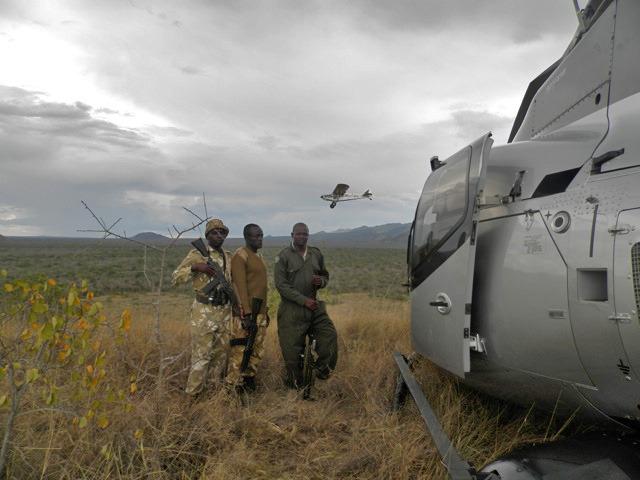
THE SEARCH FOR THE SNARED RHINO: TUESDAY, MARCH 19
This morning at first light, the team looking for snared rhino were up before first light to check the camera traps, and finally we had him on camera, drinking at a water point, but still with the wire cable embedded round his neck.
This development triggered a flurry of activity, as rangers were deployed to get onto his tracks, and a search for a helicopter. Unfortunately the KWS helicopter was unavailable and on another mission, so we had to make a hasty decision and hire a private helicopter. The cost is astronomical, and not in Big Life’s operating budget, but when gauged against not hiring it, and almost certainly losing one of the last rhinos in the ecosystem, it was easy, especially taking into account what Big Life has already invested in helping KWS save this rhino a lingering death.
Dr Poghorn, the KWS/David Sheldrick Wildlife Trust wildlife vet has dropped everything and is driving to meet the helicopter in the Chyulus as the search begins in earnest. If we don’t find him today, it will probably be the end for the Rhino.
END OF DAY :
No luck. Our gamble did not pay off. The rhino was not found. But we had to try.
Richard Bonham
THE SEARCH FOR THE SNARED RHINO: WEDNESDAYAfter yesterday’s lack of success of both helicopter AND Super Cub in the air searching for the snared rhino (see attached photo), this morning the tracker teams were on the tracks again, having found where the rhino had laid up in a steep valley, which explains why we never spotted it. We hope that they will be able to stay on the tracks and then when the rhino gets into an area where it can be darted, we will try again.We think that we know where he is headed, and so have moved two units to cut him off and with luck pick up tracks tomorrow morning.Kenya Wildlife Service has their helicopter and vet on standby awaiting news.Richard Bonham, March 20
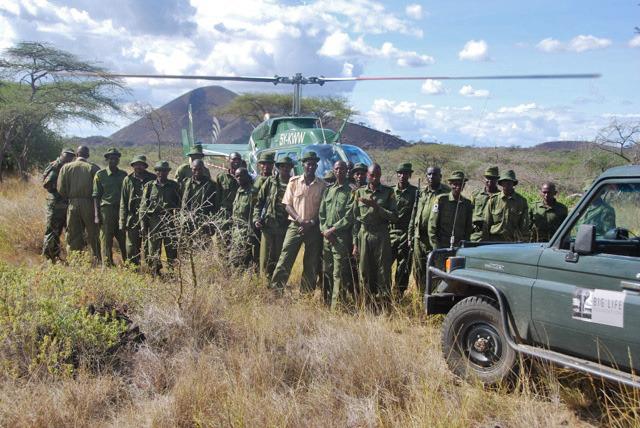
THE SEARCH FOR THE SNARED RHINO: SATURDAY
Yesterday we saw an immense effort from so many different fronts….Kenya Wildlife Service sent a helicopter and two vets, Ian Craig from the Northern Rangelands Trust arrived in his Super Cub, and the Big Life and KWS rangers were in the field from dawn to dusk for the tenth consecutive day.
Despite this, the rhino evaded us yet again. At one stage the ground team were just 20 yards from him, but he broke cover and before the helicopter could get over him, he disappeared into such thick lava-strewn forest that even the helicopter could not get a visual on him.
The bad news is the tracker teams are now finding blood and pus on branches, as he moves through the bush, so infection has set in and time is running out.
As I write, the ground teams are on his tracks again and as soon as they think they are close, will call the helicopter to assist again.
The only positive coming out of this is to see so many committed people working round the clock trying to save this poor animal.
Richard Bonham, March 23
THE SEARCH FOR THE SNARED RHINO : SUNDAY
So near but yet so far. The day started well. The Big Life and KWS Rangers, the vet Dr. Poghorn, and Ian Craig helping out from Northern Rangelands Trust, picked up tracks and some blood spoor at 7.30am, and the slow process of tracking started.
By about 10am, they knew they were closing in on the snared rhino, so they called me in the Super Cub to give some aerial support to try and spot him from the air.
At about 11am, there was a snort from the thick bush. The rhino broke cover as he had probably scented them when the wind changed. There was the receding sound of branches being crushed underfoot. And we were back to square one.
We regrouped, disheartened. Then our spirits lifted when Rob Carr Hartley rang to say what could the David Sheldrick WIldlife Trust do to help? Without a second’s hesitation. I said we need a helicopter as the KWS chopper was unavailable until tomorrow at the earliest. Rob found one within a few minutes, and it was on its way. There was a cheer from all the rangers and morale bounced back, as we know its our only real hope of getting the rhino visual and the chance of darting it.
The helicopter arrived and took up position on a hill nearby, whilst the rangers continued to follow the tracks, ready to take off at a moments notice and take up the chase once the rangers had spotted it.
But that radio call never came, and as the sun set, we had to call off the chase until tomorrow. Thanks all of you at Sheldrick's for your support yet again.
Start again tomorrow.......
Richard Bonham, March 24
THE SEARCH FOR THE SNARED RHINO : THURSDAY MARCH 28
Despite a combined force of 30 Big Life & KWS Rangers, we still have not been able to locate the injured rhino again.
Camera traps are out at all his usual haunts and patrols are combing the bush for tracks. We have not been helped by almost daily rain which hinders tracking as it washes out any signs of recent movement.
KWS still has its helicopter on standby as well as the Sheldricks… so we are in position to move quickly as soon as we get some tracks.
In the meantime, all the rangers' leave has been cancelled until we have found him.
Richard Bonham
THE SEARCH FOR THE SNARED RHINO : APRIL 5
We have had a frustrating week, with the rangers going out from dawn to dusk searching for the injured snared rhino. Then yesterday they found the tracks, confirmed by scuff marks left by the wire cable he is trailing from his neck.
Ian Craig of NRT, who is camped nearby and has been patiently waiting with his dart gun, was called in by the rangers.
They continued the painfully slow tracking through the dense forest, After about an hour, one of the trackers stopped and pointed at the just discernible, but unmistakeable rump of the rhino! They crept forward trying to get a clear shot, as the projectile dart only has to touch the flimsiest twig to be deflected,
At about 30 yards Ian was about to take aim, and a sound or waft of wind alerted the rhino that something was not right, and he thundered off into the undergrowth. Back to square one again.
We also tried the thermal imaging scope this morning from the super cub, but yet again, mother nature was not co-operating and covered the area in a bank of cloud. Later, as the cloud burnt off, it was too late to use the thermal scope as there were just too many ''hot spots'' as the lava warmed up. Tomorrow we will try again.
One strange new development is that the rangers have come up with a rather unusual tactic. Some of the rhino dung was collected and sent to a witch doctor who they say will be able to weave a spell to make the rhino stop moving…..
Richard Bonham
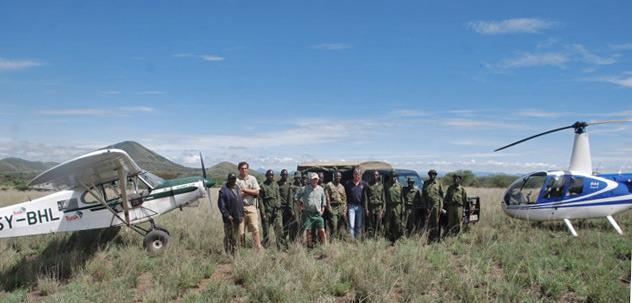
SEARCH FOR THE SNARED RHINO CONTINUES : APRIL 12, CLOSER THAN EVER
Our routine has been been pretty standard, up at 5.00am and then airborne in the Super Cub at first light with the thermal imaging equipment - whilst the ground teams deploy to their various sectors to search for the rhino's tracks.
Yesterday we had a break. I was flying the cub with Ian Craig in the observer's seat operating the thermal equipment. On our first run of the area, I hear an excited shout over the intercom..'' I think I have him, he's down there in the lava'' We swoop down and sure enough there he was. Around his neck a crimson band of congealed blood. It did not look good, as he hardly moved. Ian and I both thought we had found him too late and he was on his last legs, weakened and unable to move.
From there on, it was a blur of activity. We landed in a nearby clearing where the ground teams met us, and Ian took off on foot with his dart gun, believing it would be an easy job from here on. But when he got to where we had seen him, there was no Rhino. He had done another of his disappearing acts. I went back in the air again to see what I could spot, but again nothing as he had moved back into a thicket.
Our only hope now was a helicopter, so I called Peter Achammer, who had so kindly volunteered his time and cost rate of his helicopter to help us. I explained our situation and that the David Sheldrick Wildlife Trust had also volunteered to underwrite his cost. He said "I'll be with you in 2 hours", casting to the wind his planned weekend trip to the Mara with his family. The helicopter arrived exactly two hours later and was positioned waiting for a call by the ground teams. It did not take a long in coming. The rhino was spotted, and a smoke canister was set off to guide Peter in. He was on it in no time and circling above in the Cub, I saw the rhino galloping through the bush with the helicopter hovering above it. I thought.. Here goes… at long last, we've got him! Then Ian's voice came through on the radio. '' It's the wrong rhino. It's not injured!"
Reading the tracks, the ground crew could see that the injured rhino had joined up with another rhino and he had held his ground whilst the other rhino had shot off – with the helicopter following in hot pursuit.
So the crew got back on the right tracks. And that's when disaster nearly struck. The rhino exploded out of thick bush, charging straight towards them. Everyone went for a tree – the only escape from a rhino in this situation. Joseph Katoke, the senior rhino ranger, was not close enough to a tree and became the target of the rhino's charge. By luck there was a big rock just in front of Joseph, which the rhino stumbled on at full speed and tripped, knocking Joseph aside like a leaf in a storm. The rhino then disappeared back into the thicket. From here on, we don’t really know what happened but somehow the rhino managed to evade being spotted from the air.
You can imagine the dispondency of the whole team. After so much effort and expense and losing him – after five long weeks of dawn to dusk searches. We have been so close and having been that close, and seen the extent of his injuries, it has made it even worse.
The last two days we have been searching for him using every means possible but have been frustrated by what normally we would call the blessing of heavy rain, making the job almost impossible. Today we are all finding it difficult to remain positive, but tomorrow is another day.
We gave the rangers a choice of taking a day off yesterday as they were exhausted – mentally and physcially – but they turned it down. They say we can't give up, we have to help this rhino. So with that attitude we still have a chance.
Richard Bonham, April 12
